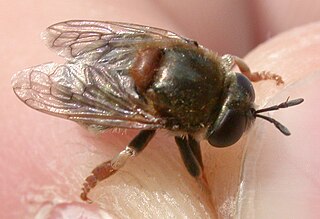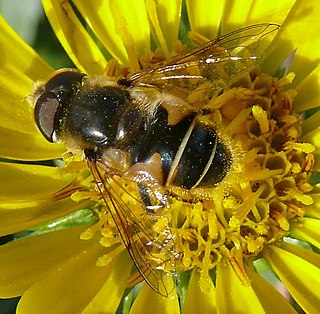
Hover flies of the genus Microdon are unusual among the Diptera. Like other members of the subfamily, they are myrmecophiles, meaning they inhabit the nests of ants.

Brachyopa flavescens, The Yellow Sapeater, is a fairly common species of syrphid fly. It has been observed in northeastern North America. Hoverflies get their names from the ability to remain nearly motionless while in flight. The adults are also known as flower flies for they are commonly found around and on flowers, from which they get both energy-giving nectar and protein-rich pollen. Larvae for this genus are of the rat-tailed type. B.flavescens larvae have not been described.

Microdon manitobensis, the Greater Ant Fly, is a species of syrphid fly in the family Syrphidae.

Palpada vinetorum is a species of syrphid fly in the family Syrphidae. It is a native flower fly species to North America, mainly found in Texas and parts of the east coast.

Meromacrus acutus, the Carolinian Elegant, is a species of syrphid fly in the family Syrphidae. This uncommon species is distributed in the Eastern United States and South America. Notable for the black and yellow pattern mimicking wasps. Hoverflies get their names from the ability to remain nearly motionless while in flight. The adults are also known as flower flies for they are commonly found around and on flowers, from which they get both energy-giving nectar and protein-rich pollen. The larvae are aquatic filter-feeders of the rat-tailed type. They are found in rot holes of trees.

Microdon megalogaster, the Black-bodied Ant Fly, is a species of syrphid fly in the family Syrphidae. It is found in North-eastern North America. Te larvae have been found in the nests of Formica subsericea the black field ant Say, and Formica fusca the silky ant Linnaeus

Blera pictipes, the Painted Wood Fly, is a rare species of syrphid fly first officially described by Bigot in 1883. Hoverflies get their names from the ability to remain nearly motionless while in flight. The adults are also known as flower flies for they are commonly found around and on flowers, from which they get both energy-giving nectar and protein-rich pollen. The larvae are of the rat-tailed type, feeding on exuding sap or in the rot holes of trees.

Brachyopa daeckei, the black-tailed sapeater, is a rare species of syrphid fly that has been observed in northeastern North America. Hoverflies get their names from the ability to remain nearly motionless while in flight. The adults are also known as flower flies for they are commonly found around and on flowers, from which they get both energy-giving nectar and protein-rich pollen. Larvae for this genus are of the rat-tailed type. B.daeckei larvae have not been described.

Eristalis hirta, the black-footed drone fly, is a common Western North American species of syrphid fly first officially described by Loew in 1866. Hoverflies get their names from the ability to remain nearly motionless while in flight. The adults are also known as flower flies for they are commonly found around and on flowers, from which they get both energy-giving nectar and protein-rich pollen. The larvae are aquatic filter-feeders of the rat-tailed type.
'Blera metcalfi , Metcalf's wood fly, is a rare species of syrphid fly first officially described by Curran in 1925 Hoverflies get their name from the ability to remain nearly motionless while in flight. The adults are also known as flower flies for they are commonly found around and on flowers from which they get both energy-giving nectar and protein rich pollen. The larvae are of the rat-tailed type feeding on exuding sap or in the rot holes of trees.
Xylota annulifera ,, the Longspine Leafwalker , is an uncommon species of syrphid fly observed across Canada and in the eastern United States. Syrphid flies are also known as Hover Flies or Flower Flies because the adults are frequently found hovering around flowers from which they feed on nectar and pollen. Adults are 7.5–11.8 mm (0.30–0.46 in) long, black with yellow abdominal spots. The larvae of this genus live under bark in sap runs.

Meromacrus gloriosus, the Glorious Elegant, is a species of syrphid fly in the family Syrphidae. Originally described from Mexico by Frank Hull in 1941 this black and yellow wasp mimic has since been observed in many locations in Texas and New Mexico.

Brachyopa cinereovittata, the Grey-striped Sapeater, is a rare species of syrphid fly. It has been observed in northwestern North America. Hoverflies get their names from the ability to remain nearly motionless while in flight. The adults are also known as flower flies for they are commonly found around and on flowers, from which they get both energy-giving nectar and protein-rich pollen. Larvae for this genus are of the rat-tailed type. B.cinereovittata larvae have not been described.

Brachyopa cynops , the Matt-tailed Sapeater, is a rare species of syrphid fly. It has been collected in Colorado. Hoverflies get their names from the ability to remain nearly motionless while in flight. The adults are also known as flower flies for they are commonly found around and on flowers, from which they get both energy-giving nectar and protein-rich pollen. Larvae for this genus are of the rat-tailed type. B.cynops larvae have not been described.

Brachyopa diversa , the Pale-striped Sapeater, is a rare species of syrphid fly. It has been observed in the northeastern part of North America. Hoverflies get their names from the ability to remain nearly motionless while in flight. The adults are also known as flower flies for they are commonly found around and on flowers, from which they get both energy-giving nectar and protein-rich pollen. Larvae for this genus are of the rat-tailed type. B.diversa larvae have not been described.

Sphiximorpha willistoni, or Williston's wasp fly, is a rare species of syrphid fly found in eastern North America. It is a strong wasp mimic. Hoverflies can remain nearly motionless in flight. The adults are also known as flower flies for they are commonly found on flowers, from which they get both energy-giving nectar and protein-rich pollen. Larvae in this genus are found in sap runs of trees.

Microdon abstrusus, the hidden ant fly, is a rare and local species of syrphid fly observed in central Pennsylvania. Hoverflies can remain nearly motionless in flight. The adults are also known as flower flies for they are commonly found on flowers though microdon species are seldom seen around flowers. Larvae have been noted in Formica exsectoides ant nests.
Microdon ocellaris, the hairy-legged ant fly, is a rare species of syrphid fly observed in the eastern United States. Hoverflies can remain nearly motionless in flight. The adults are also known as flower flies for they are commonly found on flowers, from which they get both energy-giving nectar and protein-rich pollen. The larvae have been found in the nests of Formica pallidefulva.
Microdon ruficrus, the spiny-shield ant fly, is an uncommon species of syrphid fly observed in the eastern United States and adjacent Canada. Hoverflies can remain nearly motionless in flight. The adults are also known as flower flies for they are commonly found on flowers from which they get both energy-giving nectar and protein-rich pollen. Larvae have been found from the nests of Lasius americanus formerly Lasius alienus. GBIF external link to images
Total of 245 species either found or highly expected to be found in New York.














